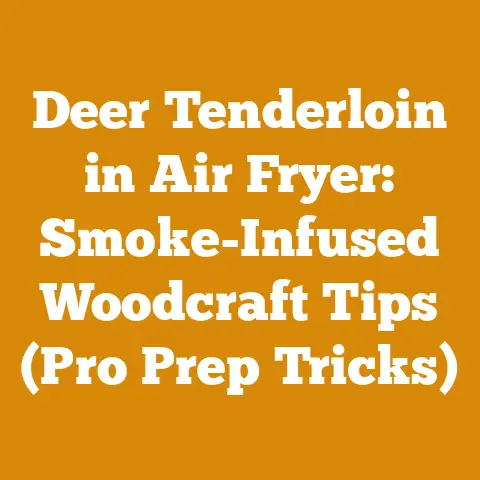Large Wood Burning Stove for Shop (5 Pro Tips for Efficient Heating)
Ever wondered if your shop could be as cozy as a cabin in the woods, even in the dead of winter? Heating a large workshop efficiently with a wood-burning stove isn’t just about throwing logs into a firebox; it’s an art and a science. Let’s unlock the secrets to keeping your workspace warm and your wallet happy.
The global firewood market is booming. Did you know that the global firewood market was valued at $26.8 billion in 2023 and is projected to reach $34.5 billion by 2030, growing at a CAGR of 3.7%? This surge is driven by rising energy costs and a renewed interest in sustainable heating solutions. But, efficiency is key; otherwise, you’re just burning money – quite literally.
I’ve spent years wrestling with chainsaws, splitting mauls, and the stubborn realities of wood processing. From my own frosty shop experiences to observing seasoned loggers, I’ve learned a thing or two about maximizing heat output and minimizing waste. Let’s dive into five pro tips that will transform your workshop heating game.
Setting the Stage: Understanding Your Needs and Stove Options
Before we even think about firewood, let’s ensure we have the right stove for the job.
Sizing Matters: Right Stove for Your Space
It’s tempting to go big, but an oversized stove in a smaller shop will just roast you out of there. Conversely, an undersized stove will struggle to maintain a comfortable temperature.
- Calculate Your Shop’s Volume: Measure the length, width, and height of your shop in feet. Multiply these numbers to get the volume in cubic feet.
- Stove Output (BTUs): Wood stoves are rated in British Thermal Units (BTUs). A BTU is the amount of energy needed to raise the temperature of one pound of water by one degree Fahrenheit.
- Rule of Thumb: A general rule is that you need about 30-40 BTUs per cubic foot in a moderately insulated space. For example, a 2000 sq ft shop with 12 ft ceilings (24,000 cubic feet) would require a stove with 720,000 to 960,000 BTUs. However, this is a very rough estimate.
- Insulation is Key: Poor insulation means you’ll need a significantly larger stove. Insulate your shop walls, ceiling, and doors to minimize heat loss. Consider adding weather stripping around doors and windows.
- Shop Layout: Open floor plans are easier to heat than spaces with many partitioned areas. If you have separate rooms, you might need a stove with a blower to circulate warm air.
My Experience: I once installed a massive stove in my old, poorly insulated workshop. It was overkill. I ended up opening windows to regulate the temperature, which completely defeated the purpose. Lesson learned: size your stove appropriately and prioritize insulation.
Stove Types: A Quick Overview
- Radiant Stoves: These stoves heat objects and people directly. They’re great for smaller, well-insulated spaces.
- Convection Stoves: These stoves circulate warm air throughout the room. They’re ideal for larger shops or spaces with multiple rooms. Look for models with built-in blowers.
- Catalytic vs. Non-Catalytic: Catalytic stoves are more efficient and cleaner-burning, but they require more maintenance. Non-catalytic stoves are simpler and more affordable.
Installation Considerations: Safety First
- Professional Installation: Unless you’re a seasoned pro, hire a certified installer to ensure your stove is installed safely and correctly.
- Clearance Requirements: Stoves need adequate clearance from combustible materials like walls, floors, and ceilings. Consult the manufacturer’s instructions for specific clearance requirements.
- Chimney: Your chimney must be properly sized and installed to ensure proper draft and prevent dangerous buildup of creosote. Annual chimney inspections are essential.
- Permits: Check your local building codes to see if you need a permit for your wood stove installation.
- Carbon Monoxide Detectors: Install carbon monoxide detectors in your shop to protect against this silent killer.
Pro Tip #1: The Science of Seasoning: Drying Wood the Right Way
Let’s get one thing straight: burning green wood is like trying to run a marathon with lead shoes. It’s inefficient, smoky, and a recipe for creosote buildup in your chimney. Seasoned wood is the lifeblood of efficient wood stove heating.
What is Seasoned Wood?
Seasoned wood is wood that has been dried to a moisture content of 20% or less. Green wood, freshly cut wood, can have a moisture content of 50% or more.
Why Seasoning Matters
- Increased Heat Output: Dry wood burns hotter and more efficiently. Water in green wood absorbs heat as it evaporates, reducing the temperature of the fire.
- Reduced Smoke: Seasoned wood produces less smoke, which is better for the environment and your neighbors.
- Less Creosote: Creosote is a flammable byproduct of incomplete combustion that can build up in your chimney and cause a fire. Burning seasoned wood significantly reduces creosote buildup.
- Easier to Light: Dry wood ignites easily and burns consistently.
The Seasoning Process: A Step-by-Step Guide
- Choose the Right Time to Cut: The best time to cut firewood is in late winter or early spring. The sap is down, and the wood will dry more quickly.
- Split the Wood: Splitting wood increases its surface area, allowing it to dry faster. Split wood into manageable sizes for your stove.
- Stack it Properly: Stack the wood in a single row, off the ground, in a sunny, windy location. This allows air to circulate freely and dry the wood evenly.
- Elevate the Stack: Use pallets, cinder blocks, or scrap lumber to raise the wood off the ground. This prevents moisture from wicking up into the wood.
- Spacing: Leave about 4 inches between rows of wood to allow for air circulation.
- Sun Exposure: Position the stack so that it receives maximum sunlight.
- Cover the Top: Cover the top of the stack with a tarp or sheet metal to protect it from rain and snow. Leave the sides open for ventilation.
- Patience is a Virtue: Seasoning takes time. Hardwoods like oak, maple, and ash typically take 6-12 months to season properly. Softwoods like pine and fir may dry faster, but they also burn faster.
- Monitor Moisture Content: Use a moisture meter to check the moisture content of the wood before burning it. Aim for 20% or less. Moisture meters are relatively inexpensive and can be found at most hardware stores.
Data Point: Studies show that properly seasoned wood can increase heat output by as much as 25% compared to green wood.
My Seasoning Setup: A Case Study
I have two dedicated firewood stacks. One is for wood that’s currently seasoning, and the other is for wood that’s ready to burn. I use pallets to elevate the stacks and cover the tops with old roofing tin. I also rotate the wood periodically to ensure even drying.
Troubleshooting Seasoning Problems
- Wood Not Drying: If your wood isn’t drying properly, it could be due to poor air circulation, lack of sunlight, or excessive moisture. Try relocating the stack to a sunnier, windier location.
- Mold or Rot: If you see mold or rot on your wood, it’s a sign that it’s not drying properly. Remove the affected wood from the stack and discard it.
- Insect Infestation: Insects can damage firewood. Inspect your wood regularly for signs of infestation. If you find insects, treat the wood with an insecticide or remove it from the stack.
Pro Tip #2: Wood Species Selection: Not All Firewood is Created Equal
Knowing your wood is like knowing your way around a toolbox. Different wood species have different burning properties. Some burn hot and long, while others burn quickly and produce more smoke.
Hardwoods vs. Softwoods
- Hardwoods: Hardwoods like oak, maple, ash, and beech are denser and burn longer and hotter than softwoods. They also produce less smoke and creosote. Hardwoods are generally the best choice for firewood.
- Softwoods: Softwoods like pine, fir, and spruce are less dense and burn faster than hardwoods. They also produce more smoke and creosote. Softwoods are best used for kindling or starting fires.
Key Wood Species and Their Properties
| Wood Species | Density | BTU/Cord (approx.) | Burning Characteristics | Notes |
|---|---|---|---|---|
| Oak | High | 24-30 million | Slow burning, hot | Excellent firewood. Can be difficult to split. Requires a long seasoning time (at least 1 year). |
| Maple | Medium | 20-25 million | Good heat, burns well | Good firewood. Easier to split than oak. Seasons well. |
| Ash | Medium | 20-25 million | Easy to split, burns well | Excellent firewood. Easy to split, even when green. Seasons quickly. |
| Beech | High | 22-28 million | Burns long, hot | Excellent firewood. Can be difficult to split. |
| Birch | Medium | 20 million | Good heat, pleasant smell | Good firewood. Burns relatively quickly. Can produce a lot of smoke if not properly seasoned. |
| Pine | Low | 15-20 million | Burns quickly, smoky | Not ideal for firewood. Best used for kindling. Produces a lot of smoke and creosote. |
| Fir | Low | 15-20 million | Burns quickly, smoky | Not ideal for firewood. Best used for kindling. Produces a lot of smoke and creosote. |
| Spruce | Low | 15-20 million | Burns quickly, smoky | Not ideal for firewood. Best used for kindling. Produces a lot of smoke and creosote. |
BTU (British Thermal Unit): A unit of heat. One BTU is the amount of heat required to raise the temperature of one pound of water by one degree Fahrenheit.
My Wood Selection Strategy: A Blend for Efficiency
I typically use a mix of oak and maple for my primary firewood. The oak provides long-lasting heat, while the maple burns a bit faster and helps to get the fire going. I also keep a supply of pine for kindling.
Sourcing Your Firewood: Local is Best
- Local Firewood Suppliers: The best place to source firewood is from a local supplier. They can provide you with seasoned wood at a reasonable price.
- Harvesting Your Own: If you have access to wooded land, you can harvest your own firewood. Be sure to obtain any necessary permits and follow safe logging practices.
- Free Firewood: Keep an eye out for free firewood opportunities, such as fallen trees or tree trimmings. Be sure to ask permission before taking any wood from private property.
Pro Tip #3: Mastering the Art of Fire Starting and Maintenance
Starting a fire in a wood stove isn’t rocket science, but there’s definitely a right way and a wrong way to do it. A well-started fire burns efficiently and produces less smoke.
The Top-Down Fire Method
The top-down fire method is a highly efficient way to start a fire in a wood stove. It burns cleaner and produces less smoke than the traditional bottom-up method.
- Layer the Base: Place several large pieces of firewood at the bottom of the stove.
- Add Medium-Sized Pieces: Layer smaller pieces of wood on top of the base, crisscrossing them to allow for air circulation.
- Kindling Layer: Place a layer of kindling on top of the medium-sized pieces.
- Top it Off: Place a few small pieces of tinder on top of the kindling.
- Light the Tinder: Light the tinder with a match or lighter. The fire will burn down slowly, igniting the kindling and then the larger pieces of wood.
Maintaining the Fire: Keep it Burning Bright
- Add Wood Regularly: Add wood to the fire regularly to maintain a consistent temperature. Don’t let the fire burn down too low before adding more wood.
- Airflow Control: Adjust the airflow controls on your stove to regulate the burn rate. More airflow means a hotter, faster-burning fire. Less airflow means a cooler, slower-burning fire.
- Ash Removal: Remove ash from the firebox regularly. Too much ash can reduce the efficiency of the fire.
- Stove Thermometer: Use a stove thermometer to monitor the temperature of your stove. This will help you to burn the fire at the optimal temperature.
Data Point: Maintaining a consistent stove temperature can improve heating efficiency by 10-15%.
My Fire Starting Ritual: A Personal Touch
I always start my fires with a handful of birch bark and a few cedar kindling sticks. The birch bark is highly flammable and ignites easily, while the cedar kindling burns hot and long.
Troubleshooting Fire Starting Problems
- Fire Won’t Light: If your fire won’t light, it could be due to damp wood, poor airflow, or not enough tinder. Try using drier wood, opening the airflow controls, or adding more tinder.
- Fire Smokes Too Much: If your fire is smoking too much, it could be due to green wood, insufficient airflow, or a dirty chimney. Try using seasoned wood, opening the airflow controls, or cleaning your chimney.
- Fire Burns Too Quickly: If your fire is burning too quickly, it could be due to too much airflow or using softwood. Try closing the airflow controls or using hardwood.
Pro Tip #4: Optimizing Heat Distribution: Spreading the Warmth
A wood stove is a point source of heat. If you don’t distribute the heat effectively, one part of your shop will be roasting while another part is freezing.
Fans and Blowers: Moving the Air
- Ceiling Fans: Ceiling fans can help to circulate warm air throughout the shop. Set the fan to run in reverse (clockwise) to push warm air down from the ceiling.
- Box Fans: Box fans can be used to direct warm air from the stove to other parts of the shop.
- Stove Blowers: Many wood stoves come with built-in blowers that circulate warm air. If your stove doesn’t have a blower, you can purchase an aftermarket blower kit.
Ductwork: A More Sophisticated Solution
- Forced-Air Systems: If your shop has a forced-air heating system, you can tie your wood stove into the ductwork. This will allow you to distribute warm air throughout the shop using the existing duct system.
- DIY Ductwork: You can also create your own ductwork system using metal ducting and a blower. This can be a more affordable option than a forced-air system.
Thermal Mass: Storing the Heat
- Masonry Heaters: Masonry heaters are large, massive structures that store heat from the fire and release it slowly over time. They’re highly efficient and provide a consistent source of heat.
- Water Tanks: You can use a water tank to store heat from your wood stove. The water tank acts as a thermal battery, storing heat during the day and releasing it at night.
Data Point: A well-designed heat distribution system can improve heating efficiency by 20-30%.
My Heat Distribution Setup: A Combination Approach
I use a combination of ceiling fans and box fans to distribute heat in my workshop. I also have a masonry heater that stores heat and releases it slowly over time.
Troubleshooting Heat Distribution Problems
- Uneven Heating: If your shop is heating unevenly, try adjusting the position of your fans or adding more fans.
- Drafts: Drafts can make it difficult to heat a shop. Seal any cracks or gaps in your walls, windows, and doors.
- Heat Loss: Heat loss can be a major problem in poorly insulated shops. Insulate your walls, ceiling, and doors to minimize heat loss.
Pro Tip #5: Safety First: Protecting Your Shop and Yourself
Wood stoves can be a safe and efficient way to heat a shop, but it’s essential to take safety precautions to protect your shop and yourself.
Chimney Maintenance: Preventing Creosote Buildup
- Annual Inspections: Have your chimney inspected annually by a certified chimney sweep.
- Regular Cleaning: Clean your chimney regularly to remove creosote buildup. The frequency of cleaning will depend on how often you use your stove and the type of wood you burn.
- Creosote Removal Products: There are creosote removal products available that can help to prevent creosote buildup.
Fire Safety Equipment: Be Prepared
- Fire Extinguisher: Keep a fire extinguisher near your wood stove. Make sure the fire extinguisher is rated for Class A fires (fires involving wood, paper, and cloth).
- Smoke Detectors: Install smoke detectors in your shop. Test the smoke detectors regularly to ensure they’re working properly.
- Carbon Monoxide Detectors: Install carbon monoxide detectors in your shop. Carbon monoxide is a colorless, odorless gas that can be deadly.
- Fireproof Mat: Place a fireproof mat under your wood stove to protect the floor from sparks and embers.
Safe Wood Storage: Preventing Fire Hazards
- Store Wood Away from the Stove: Store firewood away from the wood stove to prevent it from catching fire.
- Clear the Area: Keep the area around your wood stove clear of combustible materials.
- Don’t Overload the Stove: Don’t overload the wood stove with too much wood. This can cause the stove to overheat and increase the risk of a fire.
Data Point: Regular chimney maintenance can reduce the risk of chimney fires by 80%.
My Safety Checklist: A Personal Commitment
I have a fire extinguisher, smoke detectors, and carbon monoxide detectors in my workshop. I also have my chimney inspected and cleaned annually. I store my firewood away from the stove and keep the area around the stove clear of combustible materials.
Troubleshooting Safety Problems
- Chimney Fire: If you have a chimney fire, call the fire department immediately. Don’t try to put out the fire yourself.
- Carbon Monoxide Poisoning: If you suspect carbon monoxide poisoning, evacuate the building immediately and call 911.
- Stove Overheating: If your stove is overheating, reduce the airflow and add less wood.
Next Steps: Taking Your Workshop Heating to the Next Level
Now that you’ve learned the five pro tips for efficient wood stove heating, it’s time to put them into practice.
- Wood Stove Manufacturers: Hearthstone, Vermont Castings, Lopi
- Chimney Sweeps: Search online for “certified chimney sweep near me.”
- Firewood Suppliers: Search online for “firewood supplier near me.”
- Moisture Meters: General Tools MMD4E Digital Moisture Meter
Heating your workshop with a wood stove can be a rewarding and efficient experience. By following these pro tips and taking the necessary safety precautions, you can enjoy a warm and comfortable workspace all winter long. Now, go forth and conquer the cold!






